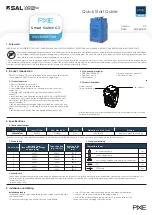MXS-9100 Optical Switch Rackmount Operation Manual
91592 Rev. A2
June 21, 2019
28
4. Handling Fiberoptic Components and Cables
Fiber optic components require special handling. Follow these guidelines when handling the
cables and connectors.
Handling Fiber Optic Cables
To avoid cable damage and to minimize optical loss, follow these guidelines when handling
fiber optic cables.
•
Handle the fiber pigtail outputs carefully.
•
The minimum bend radius for most optical cables is 35mm. Never bend an optical
cable more sharply than this specification. Optical performance will degrade, and the
cable might break.
•
Avoid bending the optical cable near a cable strain relief boot. Bending an optical
cable near a strain relief boot is one of the easiest ways to permanently damage the
optical fiber.
•
Avoid bending the optical cable over a sharp edge.
•
Avoid using cable tie wraps to hold optical cable. Tie wraps when tightened can
create micro-bends or break an optical cable. Microbends can cause a dramatic
reduction in optical performance.
•
Do not pull on the bare fiber as this can break the fiber inside the component.
•
Avoid using soldering irons near optical cables. Accidental damage can easily occur
when a soldering iron is used near an optical cable. In addition, solder splatter can
contaminate and permanently damage optical fiber connectors.
•
To assure the most stable, repeatable optical performance after the optical cables
have been connected, immobilize the cables using wide pieces of tape or another
form of mechanical cushion.
Figure 1. Optical Component Handling

















